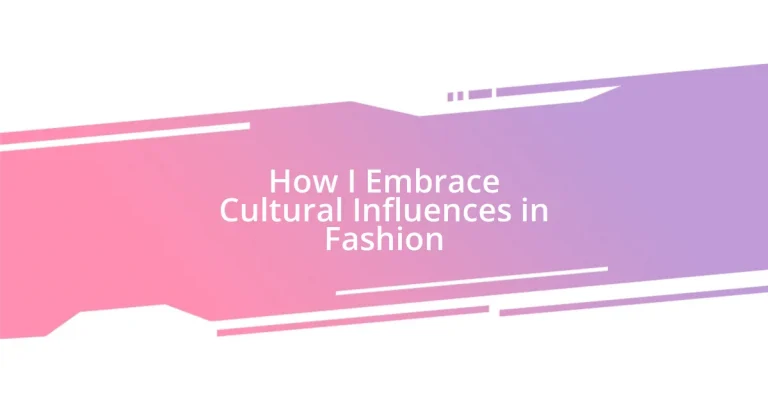Key takeaways:
- Cultural influences in fashion embody narratives that reflect the values and identities of communities, encouraging deeper appreciation and connection with these stories through personal style choices.
- Respectfully showcasing cultural elements in fashion involves understanding and honoring the narratives behind garments, promoting ethical sourcing and supporting artisans’ work while avoiding appropriation.
- Finding a balance between personal style and current trends allows individuals to express their identity authentically, integrating cultural elements thoughtfully into their wardrobe.
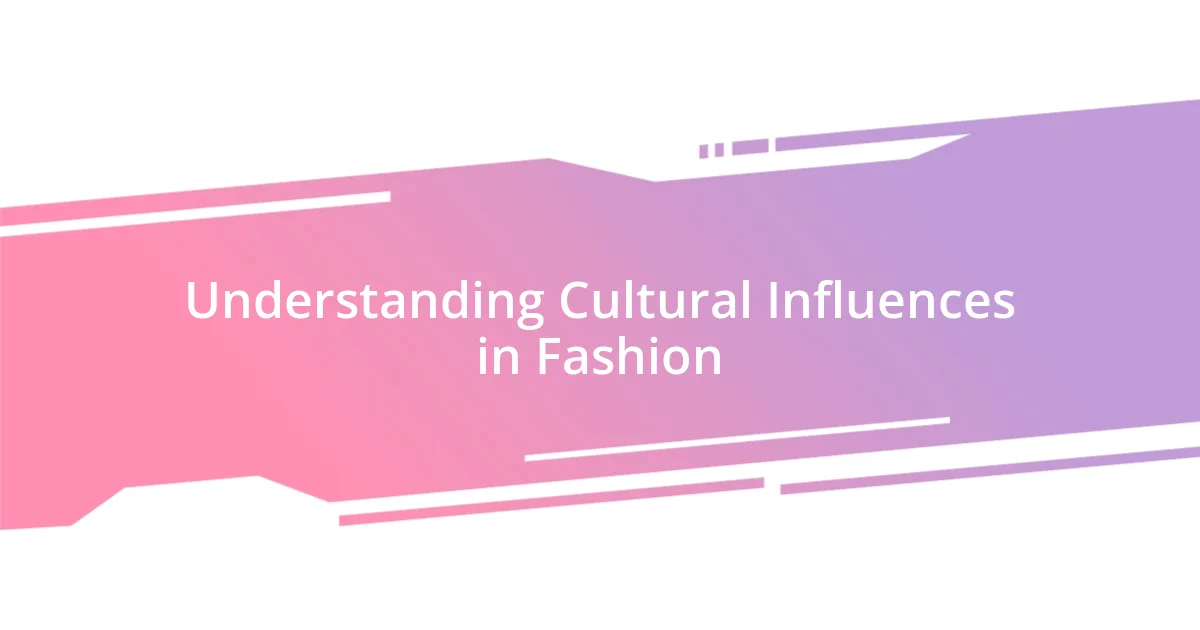
Understanding Cultural Influences in Fashion
Cultural influences in fashion are not just trends; they are vibrant narratives that reflect the values, traditions, and histories of different communities. I vividly remember the first time I wore a beautifully crafted kantha jacket, handmade by artisans in India. It wasn’t just a piece of clothing for me; it felt like wearing a story that connected me to a rich heritage.
When I think about what clothing signifies in various cultures, I can’t help but wonder how often we overlook these deeper meanings. For instance, why do certain colors or styles resonate more in some cultures than others? I once attended a cultural festival where women showcased traditional attire from their native lands, and it struck me how each outfit conveyed pride and identity, telling stories of resilience and beauty.
As I delve deeper into my own wardrobe choices, I realize clothing is a prism through which I can embrace diversity. I often ask myself how my choices can honor the cultures they come from, like when I decided to incorporate traditional African prints into my everyday outfits. This blend not only adds dimension to my style but also fosters a connection with the global tapestry of cultural expressions, something I cherish immensely.
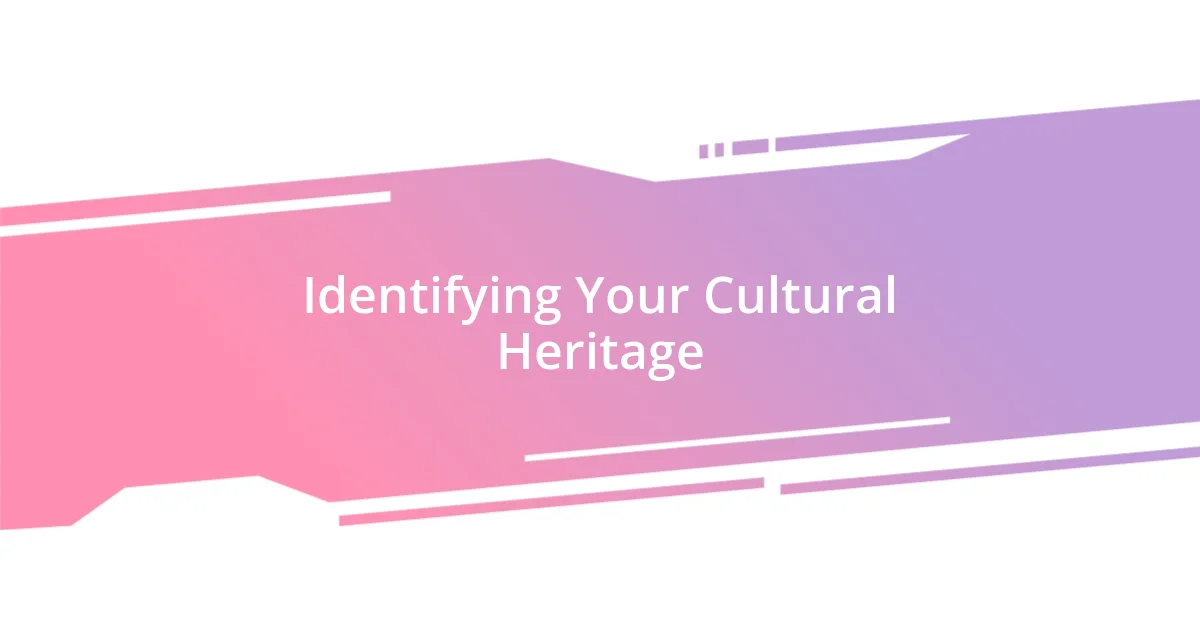
Identifying Your Cultural Heritage
Identifying your cultural heritage begins with introspection. I remember as a child, listening to my grandmother narrate stories from her youth in Italy, surrounded by vibrant fabrics and patterns that spoke of her family traditions. It made me realize that understanding my roots isn’t just about tracing lineage; it’s about connecting with the narratives that shape my identity.
Exploring cultural heritage often involves a journey into family history and traditions. One afternoon, while sifting through old family photos, I stumbled upon my great-aunt’s wedding dress, adorned with intricate embroidery passed down through generations. This discovery sparked a deeper appreciation for how clothing can carry memories and serve as a tangible link to my ancestry.
Additionally, engaging with cultural communities can illuminate aspects of your heritage you may not have known. At a recent art exhibition showcasing local artisans, I found myself captivated by a display of textiles that mirrored the stories of my region. It was a vivid reminder that cultural influences are alive and evolving, encouraging me to embrace and weave these influences into my personal fashion choices.
| Cultural Heritage Aspect | Personal Connection |
|---|---|
| Family Traditions | Understanding narratives through stories from elders. |
| Historical Significance | Discovering meaningful heirlooms that convey memories. |
| Community Engagement | Experiencing local culture through art and craftsmanship. |

Researching Fashion Trends Globally
Researching fashion trends globally has always fascinated me. I recall scrolling through social media one evening, stumbling upon a collection inspired by Japanese street style. The bold mixes of textures and colors resonated with me and taught me how significant local aesthetics can be in forming a contemporary vision. It’s a window into how global citizens express their individuality through fashion while staying rooted in their cultural backgrounds.
- Trend reports can often highlight movements in major fashion capitals like Paris or Milan, but I find it equally important to explore emerging fashion scenes across continents—cities like Lagos or Seoul are bursting with creativity.
- Engagement with global fashion weeks offers a glimpse into diverse styles, but participating in local pop-up markets or cultural fairs reveals the deeper stories behind these trends.
- Fashion blogs and cultural influencers frequently share insights that bridge the gap between traditional craftsmanship and modern aesthetics, enriching my understanding of the global fashion landscape.
In my ongoing quest to understand these trends, I often dive into documentaries that showcase textile artisans around the world. One time, I found myself moved by a film that described the meticulous process behind traditional weavings in Peru. It not only enlightened me about the artistry but also inspired me to incorporate handmade accessories into my wardrobe, making my personal style a conversation starter about culture and creativity.
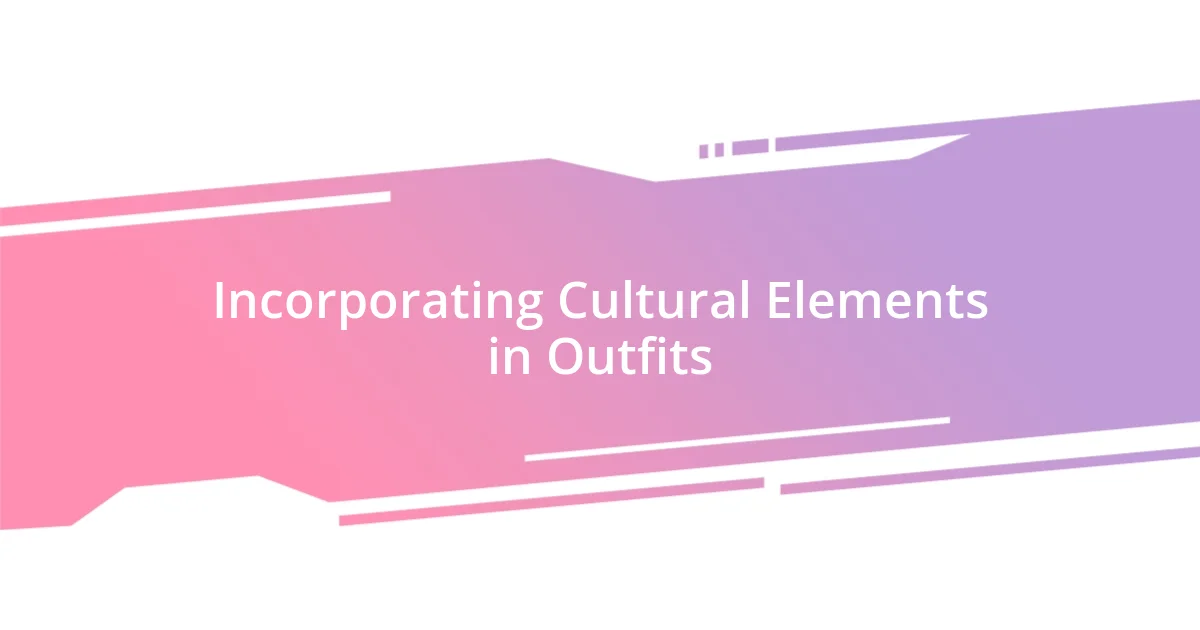
Incorporating Cultural Elements in Outfits
Incorporating cultural elements into outfits can be a beautiful expression of identity. I remember attending a festival where women showcased their traditional garments alongside modern pieces. Seeing how they blended vibrant textiles with contemporary cuts inspired me to try adding a handcrafted scarf from a local artisan to my everyday attire. It’s fascinating how such small inclusions can create a significant impact, don’t you think?
I’ve often found that the key to successfully integrating cultural elements lies in balance. For instance, wearing a dress that celebrates my heritage while pairing it with minimalist accessories allows my roots to shine without feeling overwhelming. This approach echoes my belief that fashion should reflect who we are, highlighting the parts of our identity that resonate with us most deeply.
When I discover unique cultural pieces, I make it a point to share their stories with friends. Just last week, I wore a beaded necklace from a cultural fair, and my friend asked about its origin. It provided a chance to discuss the craftsmanship and symbolism behind it, sparking a conversation about how fashion can honor tradition while still embracing modernity. In moments like these, I feel a connection not only to my roots but also to those around me—it’s like weaving a tapestry of shared experiences through our outfits.
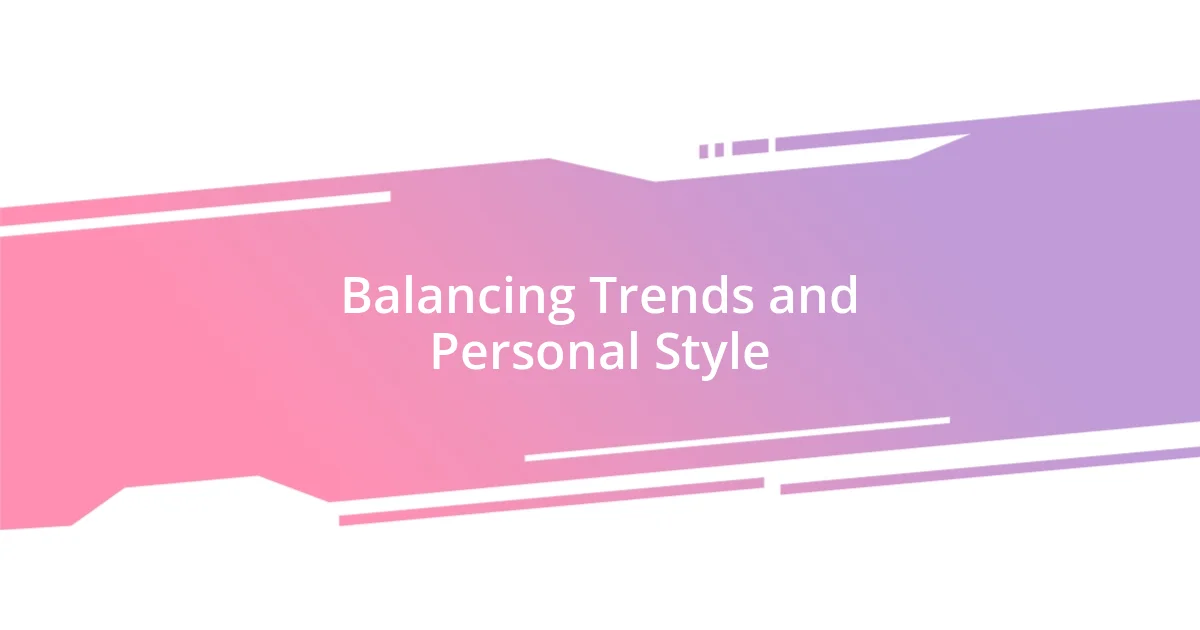
Balancing Trends and Personal Style
Finding that sweet spot between current trends and personal style can be quite a journey. I’ll never forget a time when I tried to dress in line with the latest oversized blazer trend. It looked great on others, but when I wore one, I felt like I was wearing someone else’s skin. It was a moment of realization for me: trends should enhance your identity, not overshadow it.
I often think about how styles popularized on the runway may not always feel authentic to who I am. One evening, while experimenting with layering, I found a vintage kimono tucked away in my closet. Pairing it with high-waisted jeans created a look that was both trendy and uniquely me. That moment highlighted the power of experimentation and reminded me that even the most daring trends can be adapted to reflect our personal narrative.
Balancing trends with my style is like creating a playlist—I enjoy mixing classic favorites with fresh tracks. When I see pieces that are in vogue, I ask myself: “How can this fit into what I already love?” For instance, I once incorporated a trending color palette into my existing collection of beloved accessories. This infusion gave new life to my wardrobe, proving that staying true to oneself while embracing new ideas can spark fresh creativity without losing authenticity.

Celebrating Diversity in Fashion Choices
Embracing diversity in fashion is like diving into a colorful mosaic where every piece tells a story. I recently attended a multicultural fashion show, and the experience was nothing short of exhilarating. Each model walked the runway adorned in intricate designs from various cultures, showcasing how beautifully different styles can coexist. It made me wonder: how often do we overlook the rich narratives behind the garments we wear?
One day, while sifting through my closet, I stumbled upon a pair of vibrant Indian bangles gifted to me by a friend. At first, I hesitated to wear them, thinking they might clash with my everyday look. But I decided to step out of my comfort zone. Pairing those bangles with a simple outfit turned out to be a game-changer. Suddenly, a casual ensemble transformed into a thoughtful celebration of my friend’s culture and artistry, proving that even a single accessory can infuse my attire with meaning and connection.
It’s heartening to see how fashion acts as a bridge, connecting people from diverse backgrounds. I recall a warm conversation with a fellow traveler who wore beautifully handwoven fabrics from her country, inspiring me to seek out local artisans wherever I go. Each piece is more than just fabric; it’s a conversation starter, a way to engage with the richness of our shared world. Isn’t it amazing how fashion allows us to celebrate diversity while simultaneously refining our own unique styles?
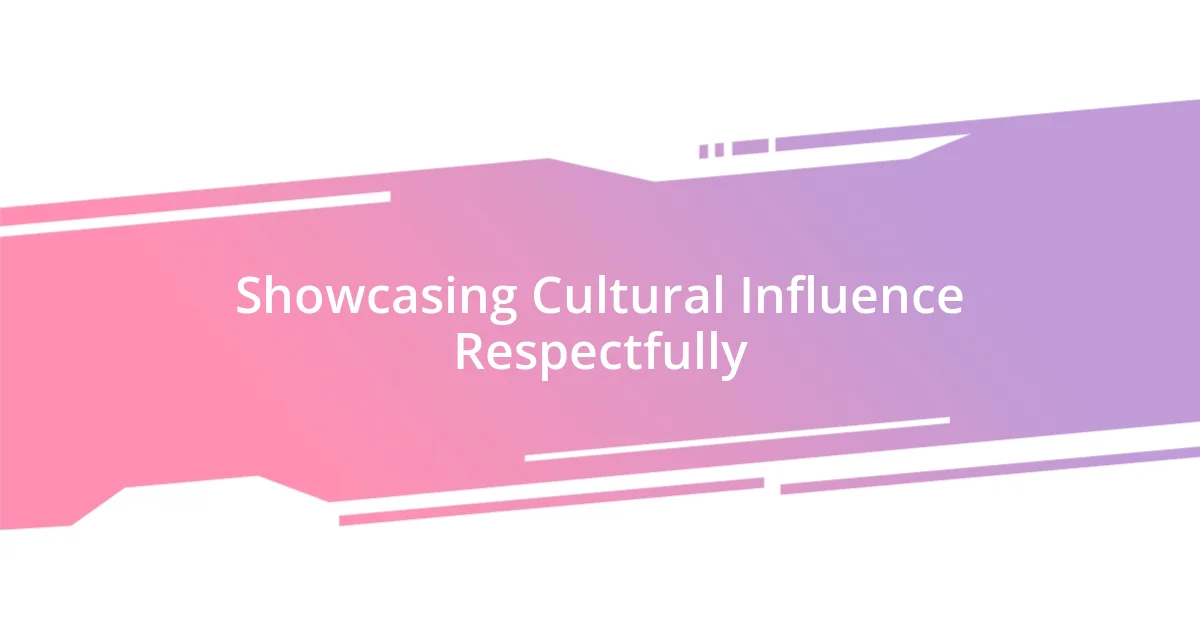
Showcasing Cultural Influence Respectfully
Showing cultural influence in fashion requires sensitivity and an understanding of the stories behind the clothes we wear. I remember attending a cultural fair where artisans showcased their handcrafted garments. I was drawn to a beautifully embroidered blouse from a local designer. Instead of buying it immediately, I engaged in a conversation with the designer about its origins. Learning about the techniques and traditions behind the artwork deepened my appreciation and transformed the way I viewed fashion. This experience taught me that understanding the cultural significance is essential before we choose to incorporate elements into our own styles.
When I don a piece inspired by another culture, I often reflect on my responsibility to represent it respectfully. I once wore a stunning African print skirt to a gathering, paired with simple accents to let the fabric shine. As compliments flowed my way, it felt imperative to share the story of its maker, a talented artisan who poured her heart into each stitch. I realized then that wearing cultural pieces is more than just fashion—it’s a way to honor those who create and celebrate their heritage. Isn’t it important to ensure our style pays homage, rather than appropriates?
Navigating the balance between admiration and appropriation can be tricky, yet it’s a journey worth taking. I’ve learned to be intentional about the cultural garments I wear; this means buying from reputable sources that uplift and empower artists. Recently, I supported a small brand that collaborates directly with indigenous artists to create ethically produced clothing. It got me thinking: how can we make this a more widespread practice in fashion? Each thoughtful purchase not only enriches our wardrobe but also supports a greater cause, reminding us all that style can be a vehicle for respect and cultural celebration.












